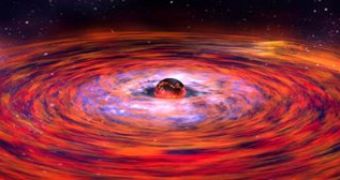How massive could a black hole in the universe be? Well, according to astronomers, they can get pretty big. At the American Astronomical Society meeting which took place yesterday, astronomers proposed that most of the massive black holes in the universe could surpass 18 billion times the mass of the Sun! Previously, it had been suggested that such massive cosmic objects could in fact exist within Quasi Stellar Objects, or quasars, but recently astronomers discovered a quasar about six times more massive than the previous record holder.
Located in the Cancer constellation about 3.5 billion light years away, the object dubbed OJ287 is part of a binary black hole system and produces a huge amount of light, fact that is usually associated with the formation of a new galaxy. Quasars mostly consist of a massive black hole, surrounded by a large accretion disk spinning around it, and are powered by the massive amounts of matter falling towards the black hole at its center. Although compacted into objects with a small size relative to the cosmic scale, during the feeding process quasars release enough energy to outshine an entire galaxy.
It seems that the quasar is being orbited by a smaller black hole, which has enabled scientists to approximate the mass of the colossal object. The OJ287 system, emits a light pulse every twelve years, which has been first observed in the years 1994 and 1995 when it released two distinctive light pulses, and more recently in 2005 when it emitted a single light signal.
The twelve years pulsing period of the quasar came somehow as a shock; however, Mauri Valtonen from the Tuorla Observatory in Finland suggested a relatively simple explanation for the phenomenon. Due to the fact that OJ287 is a black hole binary system, Mauri realized that the second black hole orbiting the quasar could pass through the accretion disk triggering a light signal. Furthermore, Valtonen has proven that the double emission experience during its first discovery must be due to the black hole's orbital trajectory which takes it not once, but twice through the accretion disk.
In order to test the theory, which predicted a second light signal, astronomers operating the German Calar Alto telescope and the Nordic optical telescope trained their instruments towards the quasar during the September and October months of the last year. Just as predicted, the OJ287 quasar emitted a light signal on the scheduled date, backing up Valtonen's theory of the black hole binary system.

 14 DAY TRIAL //
14 DAY TRIAL //